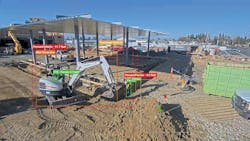Webcam Tech Keeps a Watchful Eye on the Job
Architects and builders have been touting the advantages of building information modeling (BIM) software for years. But what if there was a way to compare the digital model to the actual status of a job site at any given moment?
EarthCam introduced just that solution earlier this year. EarthCam 4D overlays and synchs live imagery of a site with the project’s digital twin. The technology merges EarthCam’s high-resolution images with Bentley SYNCHRO’s 4D models. EarthCam 4D allows users not just to zoom in and out to see both high-level and granular details, but also to scroll backward and forward in time to view the live site in relation to its digital model (the fourth dimension is time).
So project owners and builders can see precisely what happens and when, and they can track the progress of the onsite work in relation to the schedule.
EARTHCAM 4D TAKES BUILDING INFORMATION MODELING TO THE NEXT LEVEL
Developers and builders make a significant investment in BIM products, says Brian Cury, EarthCam’s founder and CEO. “That’s a very expensive undertaking, so having other ways to use that technology becomes a great return on that investment.”
EarthCam has provided webcam technologies and services for over 25 years. Headquartered in New Jersey, the company offers live-streaming video, time-lapse construction cameras, and reality-capture solutions for a variety of industries and clients, including homebuilders such as Bozzuto Construction and Frana Companies. EarthCam has documented over a trillion dollars of construction projects around the world, the company says.
Check out this time-lapse of the two-year-long construction project, Nolan Mains Residences:
Since its start in 1996, EarthCam has continually evolved and refined its technologies, Cury says. It has created faster, more responsive, and more efficient streaming videos.
For instance, EarthCam has developed solar-powered construction cameras that prove particularly useful on large lots without a nearby power supply. And among its efforts to enhance jobsite security and safety, EarthCam has developed weather sensors that can detect lightning strikes up to 25 miles away, helping to keep workers safe.
EarthCam also has created a perimeter security solution. Rather than standard motion-detection devices (like a video doorbell that sends alerts when it spots movement), EarthCam deploys AI-powered object detection. This technology can tell the difference between people and animals, it knows if a moving object is a car or a truck, and it can indicate how many vehicles it sees and whether they’re carrying concrete or lumber. And all that information helps avoid false alarms.
“Nobody pays attention if it goes off all the time,” Cury says. “We make smarter, more efficient, and less costly perimeter security solutions.”
Construction clients use EarthCam in three main ways, Cury explains: monitoring, documenting, and marketing.
THREE MAIN WAYS TO USE EARTHCAM ON THE JOBSITE
1. Monitoring
EarthCam monitors projects so all stakeholders can see what’s happening on a project in real time. Multiple cameras scan an entire job site, taking hundreds or up to thousands of photos that then get stitched together so it all looks like a single image. Users can take control of the cameras, move them around, and zoom in and out with a high degree of detail. “That helps developers and general contractors keep their eyes on the project during development,” Cury says.
2. Documenting
By recording an entire project, EarthCam provides valuable documentation of everything that happens (and doesn’t happen) on a jobsite. The live-streaming cameras amass archival history that’s especially useful for potential claims and disputes resolutions, Cury says.
And as timber becomes a more popular construction material, visual documentation helps meet its special insurance requirements. Recently, EarthCam announced it can take up to one year of continuous video recording.
3. Marketing
EarthCam’s cameras also can be used to create promotional videos of building projects. Rather than waiting until the end of the project to release a polished video, developers can use EarthCam at any point to create a presentation-ready movie. EarthCam uses AI to automatically take out any botched bits, like raindrops on a camera lens.
EarthCam today supports thousands of active construction projects. One client, Paul Smedberg, project executive, C.D. Smith Construction, said in a video statement, “There isn’t a day that goes past that I don’t log into that camera—probably five times,” said Smedberg, adding that EarthCam has cut his travel budget for each job by at least 75%. “I can see the authenticity of what’s been delivered to me via phone or email. It allows me to maintain from a visual that what I have on the schedule on paper is actually happening within the field.”


